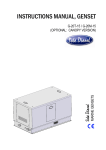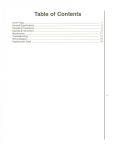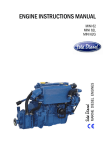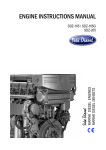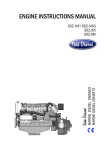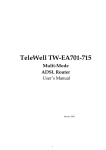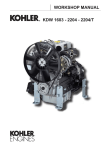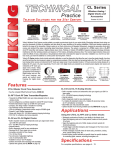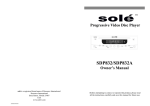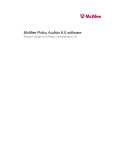Download ENGINE INSTRUCTIONS MANUAL
Transcript
ENGINE INSTRUCTIONS MANUAL MARINE DIESEL ENGINES GENERATORS SETS MINI-74G SM-105G (CANOPY VERSION) This engine instructions manual is also available in the following languages ENG SP This operator’s manual is available in English. Part no. 03917401G.ENG Este manual de instrucciones puede solicitarse en español. Ref. 03917401G.SP Download from our web page www.solediesel.com or order to [email protected] Descargar desde nuestra web www.solediesel.com o pedir a través mail [email protected] “Solé S.A. seeks for the constant improvement of its final products, for that reason the design, description, dimension, configuration and other technical specifications herein, appear just as an informative note that can not be understood as a binding offer referred to the final product. The technical specifications and presentations are subject to variations and modifications without being obliged to proceed with any previous notice”. 0. INTRODUCCIÓN 0.0 FOREWORD Dear client: The SOLÉ S.A. engine you have purchased is a product of the highest technological quality Our Service SOLÉ DIESEL department has recently been strengthened to ensure even better service for all our clients. Reliable duty and long life of the engine you have purchased can only be guaranteed if exclusively original spare parts are used, and ensure that the unit is serviced by our specialized personnel. We therefore recommend that you insist on having your SOLE S.A. engine serviced EXCLUSIVELY by our Service SOLÉ DIESEL Department. If engines manufactured by SOLÉ S.A. are serviced by unauthorized technicians, or if non-original spare parts are utilized, ALL GUARANTEE AND TECHNICALASSISTANCE OBLIGATIONS OF SOLÉ S.A. WILL BE INVALIDATED. We are confident that you will understand the importance of these recommendations, which are made for purely technical reasons and serve to defend our clients and ensure their full satisfaction with our products. Please get in touch with us for any requirements you may have. Best regards. 0.1 USING THE INSTRUCTION MANUAL 0.1.1 IMPORTANCE OF THE MANUAL This INSTRUCTION MANUAL is your guide to the USE and MAINTENANCE of the engine you have just purchased. We strongly recommend that you follow all the advice in the manual meticulously, because the correct operation and lasting reliability of the engine depend on its correct use and the methodical application of the programmed maintenance operations illustrated in these pages. If you run into difficulties or setbacks, Service SOLÉDIESEL department will be proud to provide you with the necessary advice and assistance. This INSTRUCTION MANUAL is and integral part of the product you have acquired. Please conserve it in a safe place for the full working life of the engine. SOLÉ S.A. reserves the right to make changes aimed at improving its products without any form of prior notification. Please ensure that you enclose with the original publication of the present manual any amendments or updates that you may receive. Pass on this manual to all users of the engine or future owners. 0.1.2 CONSERVING THE MANUAL When using the manual make sure that it is not damaged or defaced. Do not remove or rewrite any parts of the manual for any reason. Conserve the manual in a dry and heat protected place. 0.1.3 CONSULTING THE MANUAL This instruction manual comprises: · COVER PAGE WITH INDICATION OF THE FAMILY TO WHICH YOUR ENGINE BELONGS. The cover page shows the model of the engine described in the manual. · TABLE OF CONTENTS. Use the contents page to find the page containing information relative to a given argument. · INSTRUCTIONS AND/OR NOTES ABOUT THE PRODUCT. All the INSTRUCTIONS AND/OR NOTES ON THE PRODUCT are designed to define safety practices, proper procedures and the skills required for correct operation of the engine. The annexes at the end of this manual are an integral part of the same. Please note that the illustrations in the manual, which have been included to help you identify the parts described in the text, show standard or prototype engines and may therefore differ, in some respects, from the engine in your possession. ENG - 1 03917401G.ENG rev. 1 0.1.4 SYMBOLS IN THE MANUAL The Safety symbols and notices shown below are used throughout this publication to draw the user’s attention to situations or hazardous procedures that could damage the engine or cause personal injury, and to indicate suitable practices to assure the correct operation of the engine. GENERAL OPERATIONAL NOTE PROTECT YOUR HANDS (GLOVES) Prescription-Indication notices (rectangular); it is obligatory to adopt the protective measures shown in the notices to perform the operation in question in total safety: PROTECT YOUR EYES (SAFETY GLASSES) PROTECT (MASK) RESPIRATORY PASSAGES DANGER!, (GENERAL DANGERSITUATION FOR THE SAFETY OF ANYONE AND PROTECTION OF THE ENGINE) DANGER!, (DANGER DISCHARGES FORTHE PERSONS AND ENGINE) Danger Warning-Attention Notices (triangular); General Attention regarding personal safety and protection of the engine:. OFELECTRICAL SAFETY OF DANGER!, (DANGER FROM SOURCES OF HEAT FOR THE SAFETY OF ANYONE AND THE ENGINE) THE OPERATION INDICATED IN THE TEXT IS STRICTLYPROHIBITED Prohibition notices (circular) indicating potentially hazardous situations for personal safety: IT IS ABSOLUTELY PROHIBITED TO PERFORMMAINTENANCE WORK IN THE PRESENCE OF MOVING PARTS REMOVING OR TAMPERING WITH SAFETY DEVICES ISSTRICTLY PROHIBITED PAY ATTENTION TO SYMBOLS AND OBSERVE THE INSTRUCTIONS IN THE ADJACENT TEXT 0. INTRODUCCIÓN ENG - 2 03917401G.ENG rev. 1 1. GENERAL INFORMATION 1.1 ENGINE MANUFACTURER’S IDENTIFICATION DATA MANUFACTURER: SOLÉ, S.A. Ctra. de Martorell a Gelida, km 2 08760 MARTORELL (BARCELONA) SPAIN MODEL: _____________________________ TRADE DESIGNATION: G35T15 (MINI-74G @ 1500 rpm) G35M15 (MINI-74G @ 1500 rpm) G51T15 (SM-105G @ 1500 rpm) ______________________________ Fig. 1.1a Fig. 1.1b Mounting order Number Fig. 1.2. The above data can be quickly identified in the following position: - Engine nameplate showing identification data (see Fig. 1.1a for the old model and the Fig. 1.1b for the new aluminiun nameplate). - Markings stamped on the engine showing serial number (see Fig. 1.2) 1.2 INFORMATION REGARDING TECHNICAL ASSISTANCE / MAINTENANCE OF THE ENGINE Our after sale service is at your complete disposal to solve any problems that may arise or to supply any information you may need. For ANY explanations refer to the “SERVICE SOLÉDIESEL” address booklet. Optimal operation and efficiency of your new SOLÉDIESEL engine can only be guaranteed if original spare parts are used. For “GUARANTEE” terms refer to the “GUARANTEE CARD”. 1.3 GENERAL SAFETY NOTICES The engine is designed and built as a power unit for generating mechanical energy: ALL USES OTHERTHAN THE PRESCRIBED APPLICATIONAUTOMATICALLY RELEASE SOLÉ S.A. FROMLIABILITY FOR DAMAGES THAT MAY ENSUE, in any event, the use of products other than those agreed upon at the time of purchase, RELEASES SOLÉ S.A.FROM ALL LIABILITY FOR DAMAGE TO THEENGINE OR PROPERTY OR INJURY TO PERSONS. Although the engine is built in compliance with the most recent safety standards it is advisable to bear in mind that moving parts are always potentially dangerous. Therefore, never attempt to work on parts of the engine while they are in motion and make sure that there are no persons in the vicinity of the engine before starting it. The standard engine can run at ambient temperatures between -18 ºC a +45 ºC. The operator in charge of installing and maintaining the engine must wear suitable CLOTHING for the workplace and the situation; in particular, avoid loose clothes, chains, bracelets, rings and all other accessories that could become entangled with moving parts.. ENG - 3 03917401G.ENG rev. 1 The area in which the operator is working must be kept tidy and free of oil and other liquid spillages and solid waste (metal chips, etc.). Before starting work the operator must be aware of the position and operation of all commands and the characteristics of the engine; make a daily check of the safety devices on the engine. Disabling or tampering with the safety devices on the engine is strictly prohibited. Do not attempt to perform maintenance work adjustments or reset tings on moving parts on the engine; before performing any of the above operations disconnect the electrical supply to ensure that no other persons can start the engine up in the meantime. Do not alter any parts of the engine (for example connections, holes, finishes, etc.) to adapt it to the installation of extra equipment or for any other reason; THE RESPONSIBILITY FOR ANY TYPE OFINTERVENTION NOT EXPRESSLY AUTHORISEDIN WRITING BY SOLÉ S.A. BELONGS TO THE ONE WHO DEVELOPES SUCH WORK. SOLÉ S.A. DECLARES THAT THE ENGINE CHARACTERISTICS ARE COMMENSURATE WITH THE PARAMETERS PERMITED BY ESTABLISHED LAW REGULATIONS REGARDING THE EMISSION OF: - AIRBONE NOISE - POLLUTING EXHAUST GAS WHEN USING THE MOTOR IN A CLOSEDENVIRONMENT THE EXHAUST FUMES MUST BECONVEYED OUTSIDE.. 1.3.1 INFORMATION REGARDING RESIDUAL RISKS The engine must be used in compliance with the manufacturer’s prescriptions (technical specifications, safety regulations, etc.). Any modifications you make be previously authorized by the Manufacturer. If you use the engine beyond its application limits and alter in any way the characteristics that are the responsibility of SOLÉ S.A., such use shall be considered improper and SOLÉ S.A. declines all liability for the consequences (see notes regarding intended use in General Safety Notices 1.3). DO NOT TAMPER WITH OR MODIFY ANY MECHANICALOR ELECTRICAL COMPONENTS OF THE ENGINE WITHOUT PIOR WRITTEN AUTHORISATION FROM THE MANUFACTURER 1.3.2 SAFETY REGULATIONS IT’S STRICTLY PROHIBITED TO PERFORM MAINTENANCE WORK WHILE THERE ARE ENGINE PARTS MOVING. IT’S STRICTLY PROHIBITED TO REMOVE OR TAMPER WITH THE SAFETY DEVICES WHEN THE ENGINE IS RUNNING IT IS STRICTLYPROHIBITED TO TOUCH ANY PART OF IT ALWAYS PROTECT THE HANDS WITH SAFETYGLOVES AND HEATRESISTANT CLOTHING WHEN WORKING ON A HOT ENGINE PROTECT THE RESPIRATORY PASSAGES WHEN WORKING IN THE VICINITY OF ENGINE EXHAUST GAS ENG - 4 03917401G.ENG rev. 1 2. 2. PRELIMINARY INFORMATION ON THE ENGINE 2.1 DESCRIPCIÓN GENERAL Direction of rotation: clockwise observing engine from side opposite flywheel. Timing: pushrod and rocker arm with gear driven camshaft in crankcase. Air supply: air cleaning by means of a dry-type air filter. Fuel system: by fuel feed pump, fitted on the injection pump. Combustión system: swirl chamber and Indirect injection.. Cycle: diesel 4 stroke. Cooling: liquid cooled circulation controlled by centrifugal pump with thermostatic control and heat exchanger. Cooled exhaust collector. Injection pump: BOSCH type. Lubrication: forced-feed lubrication by trochoid pump. Electrical system: 12V / 24V (12V is the standard option). Alternator 12V: 50A (MINI74G – SM105G) Alternator 24V: 55A (MINI74G – SM105G) Starter 2.2 kW (MINI74G, 12V) Starter 3.0 kW (SM105G, 12V) Starter 2.2 kW (MINI74G, 24V) Starter 3.0 kW (SM105G, 24V) Noise Level: 65 ±3 dB (measured at 6 meters, 100% loaded get set). 2.2 COOLING CIRCUIT 2.2.1 “FRESHWATER” COOLING CIRCUIT (Fig. 2.1) use anti-freeze coolant liquid as indicated in section 4.2.2 of this manual 1) 2) 3) 4) 5) Water pump Water cooler Thermostat Bypass pipe Boiler connections (Optional) Fig. 2.1 Thermostat valve operating values: Start opening End opening MINI-74G MINI-74 / MINI-74G +71 ºC +90 ºC CIRCUIT CAPACITY (LIT.) 13.00 SM-105 / SM-105G +76,5 ºC +90 ºC SM-105G ENG - 5 03917401G.ENG rev. 1 CIRCUIT CAPACITY (LIT.) 18.00 2.2.2 “SEAWATER” COOLING CIRCUIT (Fig. 2.2) 0) 1) 2) 3) 4) 5) Bottom cock Intake connection with water filter Water pump Water / Water cooler Wet exhaust elbow Gear box cooler (only for propulsion engine) 2.3 LUBRICATION CIRCUIT Fig. 2.2 2.3.1 MOTOR 2.3.1 ENGINE Lubrication is forced with a lobe pumpand total filtration of the oil pumped tothe various lube points on the engine.The oil is forced by the pump through acontrol valve to the filter, the enginemain bearings and, by way of external pipelines, to the rocker arms. Also, read the heading 9.2. Oil circuit pressure (with hot engine): min / 800 rpm = 1.5 kg/cm2 (21.3 psi / 147 kPa) máx / 3000-3600 rpm = 3-5 kg/cm2 (43-71 psi / 294-490 kPa) ENGINE TYPE: CIRCUIT CAPACITY(1) CIRCUIT CAPACITY(2) MINI – 74G 9.0 litros 10.0 litros SM-105G 11.5 litros 12.5 litros (1) without change oil filter (only change oil) (2) Total capacity. When the oil and the oil filter are changed. (1) Main gallery (2) Oil pump (3) Oil filter (4) Oil pressure switch (5) Oil strainer (6) Drain plug 2.3.2 ALTERNATOR. Read its Service Manual attached. ENG - 6 03917401G.ENG rev. 1 Fig. 2.3.1 2.4 FUEL CIRCUIT Fig. 2.4 (1) Fuel injection nozzle Model MINI-74G SM105G (2) Fuel injection pipe (3) Fuel leak - off pipe (4 Injection pump (5) Priming pump. (6) Fuel filter. (7) Tank. (8) Fuel decanting filter (9) Fuel intake pipe. Quantity 4 6 2.4.1 INJECTION PUMP Injection pressure: 120 kg/cm2 (1707 psi / 11.77 MPa) 2.5 ELECTRICAL PLANT 2.5.1 ELECTRICAL PLANT AND INSTRUMENT PANEL Detail 1st Panel ENGINE TYPE GET SET 3-Phases 400V/230V GET SET - 1500 rpm (Part No. – 1st Panel) GET SET - 1800 rpm (Part No. – 1st Panel) 50Hz 60Hz 3-Phases 230V G-35M-15 1-Phase 110V 1-Phase 230V 60974110 60974220M 3-Phases 480V/240V 3-Phases 240V MINI-74G SM-105G G-35T-15 60974380 60974220 60974380.18 60974220.18 G-51T-15 60975380 60975220 60975380.18 60975220.18 Check the Panel Service Manual attached. ENG - 7 03917401G.ENG rev. 1 FAN - Part no. 60574041 (for cabine type A) 60574044 (for cabine type B) (1) CHECK THE ELECTRIC DIAGRAM ATTACHED INTO THE BOX PANEL. (2) CHECK THE SERVICE MANUAL ALTERNATOR TO CONNECT THE POWER. (3) ONLY FOR GENSET INSULATED. (4) AVAILABLE FOR GENSET STAR CONNECTION 400V/230V. 3 PHASES ENG - 8 03917401G.ENG rev. 1 FAN - Part no. 60574041 (for cabine type A) 60574044 (for cabine type B) (1) CHECK THE ELECTRIC DIAGRAM ATTACHED INTO THE BOX PANEL. (2) CHECK THE SERVICE MANUAL ALTERNATOR TO CONNECT THE POWER. (3) ONLY FOR GENSET INSULATED. (4) AVAILABLE FOR GENSET STAR CONNECTION 400V/230V. 3 PHASES ENG - 9 03917401G.ENG rev. 1 (1) CHECK THE ELECTRIC DIAGRAM ATTACHED INTO THE BOX PANEL. (2) CHECK THE SERVICE MANUAL ALTERNATOR TO CONNECT THE POWER. (3) ONLY FOR GENSET INSULATED. (4) AVAILABLE FOR GENSET 1-PHASE, 230V ENG - 10 03917401G.ENG rev. 1 (1) CHECK THE ELECTRIC DIAGRAM ATTACHED INTO THE BOX PANEL. (2) CHECK THE SERVICE MANUAL ALTERNATOR TO CONNECT THE POWER. (3) ONLY FOR GENSET NOT INSULATED. (4) AVAILABLE FOR GENSET STAR CONNECTION 400V/230V. 3 PHASES. NOT CANOPY VERSION. ENG - 11 03917401G.ENG rev. 1 (1) CHECK THE ELECTRIC DIAGRAM ATTACHED INTO THE BOX PANEL. (2) CHECK THE SERVICE MANUAL ALTERNATOR TO CONNECT THE POWER. (3) ONLY FOR GENSET NOT INSULATED. (4) AVAILABLE FOR GENSET STAR CONNECTION 400V/230V. 3 PHASES. NOT CANOPY VERSION. ENG - 12 03917401G.ENG rev. 1 2.6 TECHNICAL SPECIFICATIONS UNIDADES Cylinders number Bore Stroke Total desplacement Compression ratio Min. Ilding speed Max engine speed Max assembly angle (Cont.) MAX assembly angle Crankshaft power ISO-8665 mm mm c.c. r.p.m. r.p.m. º º kW / CV MINI74G 4 94 120 3331 22:1 1500 1500 ----32 / 43.5 SM105G 6 94 120 4996 22:1 1500 1500 ----51.4 / 70 Oil capacity (oilpan) Min oil pressure (hot engine) Cooling water capacity Injection pump Injection pressure Ignition sequence liters kg/cm2 9 1.5 11.5 1.5 liters 13.0 BOSCH 120 1-3-4-2 Valve timing (intake open) Valve clearance (cold engine) Ø Int. Hose, Sea Water Ø Int. Hose, inlet fuel oil Ø Int. Hose, return fuel oil Weight dry (kg) BTDC mm 19º 0.25 18.0 BOSCH 120 1-5-3-62-4 18º 0.25 mm mm mm G35M15 G35T15 30 8 8 30 8 8 bar G51T15 (b) ALTERNATOR UNITS Type System cooler Voltage V Frequency Hz Ampers A MAX. Power (kW) Continuous Power (kW) Power Correction (cos φ) Insulation system Voltage Variation Frequency Variation V Hz Revolving field, 4-poles. Rigidly coupled to Enghien and permanently aligned. Skewed stator and 2/3 pitch windings minimize field heating and voltage harmonics. Resin-coated for corrosion protection. Rotor dynamically balanced. Direct-coupled to the engine by drive discs. Air 400/230 (3-phases) or 400 (3-phases) 230 (1-phase) 50 (1500 rpm) 60 (1800 rpm) 50 (3-phases) - G35T15 (50 Hz/400V) 72 (3-phases) - G35T15 (50 Hz/400V) 87 (3-phases) - G35T15 (50 Hz/230V) 125 (3-phases) - G35T15 (50 Hz/230V) 35 (1-phase) – G35M15 (50 Hz) 42.4 (3-phases) – G51T15 (50 Hz/400V) 28 (3-phases)–G35T15 (50 Hz/400V) 40 (3-phases) – G51T15 (50 Hz/230V) 33 (1-phases) – G35M15 (50 Hz) 38 (3-phases) – G51T15 (50 Hz/400V) 28 (3-phases) – G35T15 (50 Hz) 1 (1-phase) 0.8 (3-phases) H ±2 ±3 ENG - 13 03917401G.ENG rev. 1 2.6.1 ENGINE DIMENSIONS CABINE TYPE A G-35T-15 / G-35M-15 Cabine type A available for engines with serial number: 161271, 161277, 161279, 161281, 161282, 161284, 174171, 174174, 174175, 174181. ENG - 14 03917401G.ENG rev. 1 CABINE TYPE B Colour: White (RAL 90-16) GET SET A (mm) B (mm) C (mm) D (mm) G-35T-15 G-35M-15 800 800 1080 1080 1600 1600 260 260 G-51T-15 890 1210 1900 345 ENG - 15 03917401G.ENG rev. 1 CABINE TYPE C G-35T-15 G-35M-15 A (mm) 800 800 B (mm) 1080 1080 C (mm) 1600 1700 D (mm) 260 260 G-51T-15 890 1210 1900 345 ENG - 16 03917401G.ENG rev. 1 GEN SET G-35T-15 GEN SET G-51T-15 ENG - 17 03917401G.ENG rev. 1 2.7 CONNECTIONS. (1) CABINE TYPE (A) Fan. NOT COVER. Covers to replace the oil or coolant. Check the levels. Inlet fresh air. NOT COVER. IS NECESSARY FREE SPACE 400/500 mm FROM A WALL OR OTHER CABINE Panels to check the engine Inlet fuel. Inlet raw water refrigeration. Outlet Wet Exhaust system Brackets for the transport. Is available to dismantle. ENG - 18 03917401G.ENG rev. 1 Little Windows for the electrical coenctions Leaks coolant (2) CABINE TYPE (B) Fan. NOT COVER. Covers to replace the oil or coolant. Check the levels. Inlet fresh air. NOT COVER. IS NECESSARY FREE SPACE 400/500 mm FROM A WALL OR OTHER CABINE Panels to check the engine Little Windows for the electrical coenctions Inlet fuel. Inlet raw water refrigeration. Outlet WetExhaust system Leaks coolant Brackets for the transport. Is available to dismantle. ENG - 19 03917401G.ENG rev. 1 (3) CABINE TYPE (C) Fan. NOT COVER. Inlet fresh air. NOT COVER. IS NECESSARY FREE SPACE 400/500 mm FROM A WALL OR OTHER CABINE Panels to check the engine Little Windows for the electrical coenctions Inlet fuel. Inlet raw water refrigeration. Leaks coolant Outlet WetExhaust system Pipes to connect the Airvent. OPTIONAL. Brackets for the transport. Is available to dismantle. ENG - 20 03917401G.ENG rev. 1 3. TRANSPORT, HANDLING, STORAGE 3.0 GENERAL WARNINGS Refer to heading 1.3 for safety information. 3.1 PACKING AND UNPACKING The engine is shipped in various types of packing systems: Pallet with wooden crate (See heading 3.1.1) -Pallet with skeleton crate (See heading 3.1.2) -Engine mounting base + plastic packaging(See heading 3.1.3) STORAGE covered area only. STACKING OF PACKS: Max. 1+1 covered area only. NO covered area only. NO 3.1.1 PACKING AND UNPACKING WITH PALLET AND WOODEN CRATE Remove the lower nails. Lift the engine using chains with safety hooks and of suitable load capacity. Attach the chain hooks to the engine eyebolts and lift using a forklift or other suitable lifting equipment as described in heading 3.3. Transfer the engine to the intended position of installation and remove the plastic wrap film. Unscrew screws that secure the engine to the wooden base withdraw the base and proceed with installation operations. 3.1.2 PACKING AND UNPACKING WITH PALLET AND SKELETON CRAT Remove the lower nails. Lift the engine using chains with safety hooks and of suitable load capacity. Attach the chain hooks to the engine eyebolts and lift using a forklift or other suitable lifting equipment as described in heading 3.3. Transfer the engine to the intended position of installation and remove the plastic wrap film. Unscrew screws that secure the engine to the wooden base with draw the base and proceed with installation operations. 3.1.3 PACKING AND UNPACKING WITH ENGINE MOUNTING FIXTURE AND PLASTIC PACKAGIN Lift the engine using chains with safety hooks and of suitable load capacity. Attach the chain hooks to the engine eyebolts and lift using a fork lift or other suitable lifting equipment as described in heading 3.3. Transfer the engine to the intended position of installation and remove the plastic wrap film. Unscrew screws that secure the engine to the wooden base with draw the base and proceed with installation operations. 3.2 RECEIPT When the engine is delivered make sure that the packing has not been damaged during transport and that it has not been tampered with or that components inside the packing have been removed (see information marked on covers, bases and cartons). Place the packed engine as close as possible to the place of installation and remove the packing material, checking that the goods supplied correspond to the order specifications. if you notice damage or missing parts, inform solé diesel assistance departments and the carrier immediately and foward photographic evidence of the damage important: After inspecting the goods if you notice damage etc. write are servation on the delivery note. Have the carrier countersing the note and advise SOLE S.A., preferably by telefax. ENG - 21 03917401G.ENG rev. 1 3.2.1 PACKING LIST (1) ASSEMBLED ENGINE (2) TECHNICAL DOCUMENTATION The technical documentation contains: instruction and user manual. Packing material must be disposed of in compilance with established law in the user’s country. Packing materials: Wood Steel nails Steel screws Plastic film Cardboard Metal or plastic straps 3.3 TRANSPORT AND HANDLING THE PACKED ENGINE When lifting and transporting the engine use EXCLUSIVELLY a fork lift or bridge crane of appropiate load capacity, with chains equipped with safety hooks suitable for lifting the load. The use of any other system automatically invalidates the insurance guarantee against possible damage to the engine. 3.4 TRANSPORT AND HANDLING OF THE UNPACKED ENGINE When the engine is unpacked ready for transport, use EXCLUSIVELLY theap propiate lifting eyebolts (A), see the picture 3.4. Fig. 3.4 Choose the lifting equipement with reference to heading 3.3. 3.5 STORAGE OF PACKED AND UNPACKED ENGINE If the engine is left idle for prolonged periods, the client must check the possible conditions of conservation in relation to the place of storage and the type of packing system (base, pallet, etc.). If the engine is unused for prolonged periods and stored, observe all the relative technical specifications. The treatment of the engine for storage is guaranteed for6 months after the time of delivery.. if the user decides to start the engine after a longer time period, this must be done in the presence of an authorised technician ENG - 22 03917401G.ENG rev. 1 4. INSTALLATION 4.0 GENERAL WARNINGS Refer to heading 1.3 for safety information. 4.1 ASSEMBLY DATA TIGHTENING VALUES THREAD Cylinder head bolts Crankshaft pulley to crankshaft Main bearing bolts Connecting rod bolts Flywheel bolt Oil pan drain plug Oil filter Pressure relief valve M12 x 1.75 M30 M14 x 2 M10 x 1.25 M12 x 1.25 M14 --M22 x 1.5 ----M10 x 1.5 M10 x 1.25 M10 M10 M10 M12 M6 M8 M10 M12 Holder body retaining nuts Glow Plug Nut for B Terminal of starter Reversing gear flane setscrew Water cooler element lock nuts Reversing gear body set screw Oil gearbox drain plug General tightening torque MINI-74G / SM-105G (kgf · m) 12.0 50.0 10.5 5.5 8.5 4.0 1.2 5.0 --3.75 1.8 1.1 12.0 5.0 5.0 3.5 0.5 / 0.7 1.2 / 1.7 2.2 / 3.4 3.6 / 6.1 (lbt · ft) 87.0 362 76.0 40.0 61.0 29.0 9.0 36.0 --27.0 12.0 8.0 87.0 36.0 36.0 25.0 4/5 9 / 12 16 / 25 26 / 44 CYLINDER HEAD BOLTS TIGHTENING SEQUENCE: When bolting the cylinder head, clean throughly the contact faces and fit the head gasket. Retighten one screw at a time when engine is cold as indicated in the suitable drawing. Loosen must be done using the reverse sequence. MINI-74G SM-105G ENG - 23 03917401G.ENG rev. 1 4.2 ENGINE SUPPLIES 4.2.1 CHANGING OIL 4.2.1.1 CHANGING ENGINE SUMP OIL Use oil that corresponds to the technical specifications in chapter 9. Oil shall be changed with a hot engine so as to be sure the oil is fully drained. This is done by removing the stopper and mounting the drain pump. (Fig. 4.1). When drained, fill with fresh oil through the filler hole.(Fig. 4.2). Oil sump capacity: see heading 2.6 (technical specifications). Immediately operate engine at idling for some minutes until the dashboard control light is switched off. Fig. 4.1 Stop engine. Check filter and engine sealing. Check then oil level, by removing the rod (Fig. 4.3), cleaning it witha rag and repositioning it by retightening. Remove it again immediately to check oil level and if it does not reach the top sign add carefully more oil through the filler hole (Fig. 4.2) up to the top rod sign. Fig. 4.2 Fig. 4.3 be careful that any rod marks refer to the engine at a horizontal position. Therefore, check the engine inclination when the level is verified. Read chapter 9.2 warning: the use of oil that does not conform to the technical specifications on chapter 9 will cause serious damage to the engine and invalidate the guarantee. when supplying the engine never ingest oil, fuel, coolant liquid, etc.. these substances are harmful to the personal health of the user if ingested ENG - 24 03917401G.ENG rev. 1 4.2.2 FILLING THE COOLING CIRCUIT As a refrigerating liquid, an anti-freeze of the brand KRAFFT ACU 2300 CC 50% Ref. 1325 or another one with similar specifications must be used. The incorrect use of water in the refrigeration circuit is extremely harmful, causing corrosion and scaling, while the use of anti-freeze protects the circuit from corrosion, scaling and from freezing in conditions of very low temperature, thus optimizing engine maintenance and reliability. Fig. 4.7 warning! do not allow AC88 liquid to come into contact with the eyes or the skin warning! do not ingest any of the liquids utilized to fill the various circuits on the engine When distilled water is used in the refrigeration circuit, an anti-freeze product must be added, otherwise the expansion of water when it freezes may produce cracks and damage to the refrigerator unit and to the block, and in proportion to the temperatures expected. The anti-freezing agent manufacturer, in the package labels is giving the instructions to be followed at each case. However, in the following box, suitable rates a reset out in accordance with temperatures: Ant freezing liquid concentration ( %) Freezing temperature (ºC) 30 -10 40 -20 50 -30 60 -45 It is advisable the anti-freezing agent strength is selected based on a temperature which is approx. 5ºC under the actual atmospheric temperature. The anti-freeze solution recommended can be used fora normal operation of 2 years. At the end of this period of time the refrigeration circuit must be emptied and cleaned, then refilled with the predetermined anti-freeze (see 4.2.2). Run the engine for a few minutes until the cooling circuit is properly filled and free of air pockets. Check the coolant level and replenish if necessary. warning! after the first 50 hours of engine duty and at six months or 1000 hours intervals thereafter, addrust inhibiting agent AC88 to the coolant in the same proportions as indicate earlier. The cooling liquid mixture must be topped up with identical mixture and totally drained and replaced every 2 years. warning! the use of coolants that are not in conformity with the above prescriptions will cause damage to engine components and invalidate the terms of the guarantee. 4.2.3 REFUELING Always use clean, filtered gas oil. Never use either kerosene or heavy oils. On topping up with fuel, use a funnel with a metallic mesh filter, to keep out impurities or foreign bodies which may cause problems in the fuel injection circuit. Whenever possible, keep the fuel tank full, as temperature changes may cause condensation of the damp air present in the tank so that water accumulates at the bottom, giving rise to corrosion or making it impossible to start the engine if this is aspirated by the fuel pump. ENG - 25 03917401G.ENG rev. 1 Check all tank filling plugs located at the boat deck are sealed.. warning! Do not use diesel fuel mixed with water or any other foreing substances warning! Always use top quality fuel of certified origin. the use of diesel fuel that does not comply with the technical specifications indicated above will cause serious damage to the injection system and hence to the engine and also invalidate the terms of the guarantee 4.3 INSTALLATION warning! When water-cooled engines must be located in an enclosed place or protected by guards or a cabinet, it is important to ensure thatcombustion air is freely supplied and freely expelled from the area The above recommendation is of primary importance in relation to the perfect operation of the engine because the hot air that it generates must never be routed to the area of the combustion air intake cleaner. If the users fails to take these precautions, a hot air recirculation system will be formed thus reducing engine power output and obstructing proper cooling. In these cases it is advised to take steps to avoid taking in engine combustion air from the place in which the engine is installed. This is achieved by placing the suction filter, or a suction pre-filter, outside the place in which the engine is installed. 4.4 INDICATIONS FOR REMOVAL / DISPOSAL OF WASTE MATERIAL warning! Disposal of waste material must be carried out in conformity with established legislation in the country of installation. ENG - 26 03917401G.ENG rev. 1 5. PREPARING THE ENGINE FOR USE 5.0 GENERAL WARNINGS Refer to heading 1.3 for safety information. 5.1 INSTRUCTIONS FOR FIRST STARTING Do not alter the functioning conditions of the engine by changing the settings of factory sealed parts. Tampering with such parts automatically invalidates the guarantee. Proceed as follows when starting the engine for the first time: (a) FILLING WITH OIL See heading 4.2.1 and heading 2.6 for oil sump capacity. (b) FILLING WITH COOLANT (See heading 4.2.2) (c) REFUELING. See heading 4.2.3. Check fuel delivery cock is fully opened. (d) OPEN SEAWATER ENTRY COCK (e) CONNECT THE BATTERY CONNECTOR (f )OTHER CHECKINGS (g.a) Carefully check the engine positioning points. (g.b) Check all screws are correctly tightened. (g.c) Check all water, oil and gas-oil pipe nipples, verifying if all them are well connected and correctly tightened. (g.d) Check exhaust and transmission systems. 5.1.1 BLEEDING AIR FROM THE FUEL SUPPLY SYSTEM On the first start-up of the engine, and if this has operated with the fuel tank empty, air may enter the feed system, and it is necessary to purge this. To carry out the priming/purge of the fuel system, proceed as follows: - Check fuel cock located at the fuel tank to be opened. - Loosen air vent plug (1) (approximately 1.5 turns). - Unlock the priming pump moving its plug counterclockwise. (Fig 5.3.1 and 5.3.2) - Operate the priming pump (Fig. 5.3.3) - When the fuel flows free of bubbles, lock the priming pump, then tighten the plug (1) (Fig 5.3.1). -Clean up fuel spillage. Once this operations have been terminated proceed to start the engine (see heading 6.1) ENG - 27 03917401G.ENG rev. 1 Fig. 5.3.1 Fig. 5.3.2 Fig. 5.3.3 Atention! If the vent plug (1) is closed before the priming puma plunger is locked (2), fuel pressure acts on the feed puma, resulting in inability to restore the plunger. 5.2 PRELIMINARY RUNNING TESTS 5.2.1 NO-LOAD RUNNING TEST Run the engine at low speed for a few minutes. Keep a constant check on the oil pressure (see heading 2.3). 5.2.2 RUNNING-IN During initial run-in, may last lasts for the first 50 hours of duty, take into account the following points: (1) Daily checking performances must be made without failure. (2) Engine must be operated at idle speed and heated up minimum 5 minutes after its starting. (3) Avoid a speeded-up acceleration. (4) Use the engine at 100% of maximum power for limited periods. (5) Carefully comply with the inspection and maintenance instructions shown in this manual. warning! The longer the initial running-in period with reduced loads, the longer will be the working lifetime of the various parts of the engine with consequent savings in terms of maintenance and running costs ENG - 28 03917401G.ENG rev. 1 6. USING THE ENGINE 6.0 GENERAL WARNINGS Refer to heading 1.3 for safety information. 6.1 START THE GET SET. To start get set from MDA panel (1st panel) is necessary to push the GREEN boton. The get set spend 4-5 seconds to start. Check the service manual attached. For installation double panel, is not possible start from MDA panel and stop for the auxiliary panel. The MDA panel can be switch on to check the values. To start from AUXILIARY panel, turn the key to right hand (Pos. RUN) and pusch the boton named “CRANK”. Use the pre-heating bottom only during 4-5 seconds 6.2 STOP THE GEN SET. From MDA panel, push the red boton. Check the service manual attached. To stop the get set from auxiliary panel, turn the key to left and (Pos. OFF). 6.3 USING THE ENGINE INFREQUENTLY Take special precautions in installations where the engine must cut in rapidly and suddenly after long periods of inactivity (emergency power systems, fire prevention systems and harsh ambient conditions). For specific application conditions consult SOLÉ DIESEL. 6.4 OPERATING THE ENGINE AT LOW TEMPERATURES Whenever the atmospheric temperature drops below zero, the following series of circumstances occur: (1) (3) (5) The cooling liquids of the engine may freeze. There is a grop in the voltage at the battery terminals. The fuel loses fluidity. (2) (4) The lubricating oil becomes thicker. The air inlet temperature is low and the engine has difficulty in starting. To prevent the damage caused by low temperature operation, the engine should be prepared as follows: (1) Use anti-freeze as indicated in section 4.2.2 of this manual. (2) When the engine is to be stopped, close the sea water cock, open the sea-water filter cover and start the engine adding a mixture of fresh water and 30% anti-freeze until the sea-water circuit is filled completely. Stop the engine and replace the sea-water filter cover. Before starting the engine again, open the sea-water cock. Repeat this operation whenever the engine is used at temperatures below ºC. (3) Make sure that the lubricant oil is good quality and has a suitable viscosity. SAE 10W/30 synthetic oil is recommended. (4) Protect the battery against the cold, covering it with an adequate material. Check that the battery is fully charged. It is also advisable to use a dielectric spray on the electrical connections. (5) When starting the engine, make sure that the heating plugs become hot enough. Follow the instructions detailed in section 6.1 of this manual. (6) If necessary, to replace the fuel with a type more suited to low temperature operation. The accumulation of impurities in the fuel tank could cause faulty firing. ENG - 29 03917401G.ENG rev. 1 6.5 CONSERVATION warning! All engines not in use are subject to rusting and corrosion of machined surfaces that are not protected with a paint coating. The degree of corrosion depends on meteorological changes and climatic conditions. The following recommendations are therefore of a general nature but they will help prevent or reduce the risk of damage due torusting 6.6 LONG INACTIVITY INSTRUCTIONS When the engine is not to be used for a long period of time or during the winter time, certain operations must be carried out to keep it in perfect operationing condition. Follow these lay-up instructions carefully. (1) Carefully clean the external surface of the engine. (2) If very low temperatures are expected, always use liquid anti-freeze in the refrigeration circuit as indicated in section 4.2.2 of this manual. (3) In the case of low-capacity fuel tanks, drain completely and clean; refill with a mixture of diesel oil and rust inhibitor oil. For diesel oil in large-capacity fuel tanks, it is enough to add 2% rust inhibitor oil. (4) Close the sea-water cock. Connect a hose from the sea water pump to a open bucket. Put 30% anti-freeze mixture to the bucket. Start the engine for a moment. So the sea water system will be filled with anti-freeze mixture. Stop the engine. Use a dielectric spray on the electrical connections, disconnect the battery, and charge it several times during the period of inactivity. (5) 6.7 RESTORATION OF THE RUNNING CONDITIONS When starting up the engine again after winter lay-up, certain operations must be performed. Follow these steps: (1) Fill the fuel tank with clean diesel oil. Carry out the process for checking the fuel filter. If the filter is clogged, replace the filter cartridge. The diesel oil-rust inhibitor oil mixture placed in the tank for winter lay-up can be used to operate the engine. (2) Drain the rust inhibitor oil contained in the crankcase and refill the engine sump with oil according to the instructions on heading 4.2.1.1. (3) Check the condition of the fresh-water cooling system rubber hoses. (4) Reconnect the battery and apply a layer of neutral Vaseline to the battery terminals. (5) Remove the nozzle supports and clean them. If possible, verify the setting of the nozzles at a workshop. Turn the engine without nozzles, using the starter motor, to eliminate the rust inhibitor oil used in the winter. Then install the clean nozzles. (6) Connect the cooling and exhaust system. Open the sea-water cock. (7) Verify whether there are any leaks in the fuel and water systems. (8) Start up the engine and try out at different speeds, making sure that the water flows correctly. Check again to see if the connectors leak. ENG - 30 03917401G.ENG rev. 1 7. REPAIR AND MAINTENANCE 7.0 GENERAL WARNINGS Refer to heading 1.3 for safety information. 7.1 TYPE AND FREQUENCY OF INSPECTIONSAND MAINTENANCE INTERVENTIONS INCREASE THE FREQUENCY OF MAINTENANCE IN HARSH DUTYCONDITIONS. (FREQUENT STOPS AND STARTS, DUSTY SURROUNDINGS, PROLONGED WINTER SEASON, NO-LOAD RUNNING) IF POSSIBLE CHECK LEVELS ANDREPLENISH SUPPLIES WITH THEENGINE STOPPED AND ATAMBIENT TEMPERATURE WARNING! RISK OF BURNS DURINGMAINTENANCE OPERATIONSCARRIED OUT WHEN THE ENGINEIS HOT. WEAR SUITABLE SAFETYCLOTHING IT IS STRICTLY FORBIDDEN TOCLEAN THE ENGINE WITHCOMPRESSED AIR IT IS STRICTLY FORBIDDEN TOPERFORM MAINTENANCE/CLEANING OPERATIONS IN THE PRESENCE OF MOVING PARTS USE GLOVES, OVERALLS ETC. TO PROTECT THE BODY FROM BURNS Daily Inspection concept Engine Lubrication system Screw tightening, fixing Valve play Exhaust gases, noise vibrations Compression pressure 1ª 50 hour Service interval Cada 200 Cada 400 hour hour Cada 800 hour Every 2 years and Engine oil Oil filter Fuel system Fuel Fuel tank Fuel filter (engine) Decanting filter (if any) Injection pump Injector Bleed fuel system Intake system Air filter Cooling system Cooling water Water filter Bottom cock Water pump impeller Cleaning Change ENG - 31 03917401G.ENG rev. 1 Inspection, adjustment or filling Drainage Inspection concept Electrical system Daily 1ª 50 hour INTERVALOS Cada 200 Cada 400 hour hour Cada 800 hour Every 2 years Every instrument Incandescent spark plug Alternator and starting motor Alternator belt and tension Battery level Exhaust Protections Cleaning Change DAILY CHECKING BEFORE USE OF THE ENGINE Inspection, adjustment or filling Drainage AFTER THE FIRST 50 OPERATING HOURS Check oil level in the engine and gearbox. Filling. Filling is not required if level is near to the rod upper line. Check fuel level and open fuel delivery cock. Change oil engine, gearbox and cover fuel supply pump. Open the water access cock. Check indicators. After commisioning check oil pressure, water temperature and battery charge. The three lamps must be switched off and the alarm must not be sounded.. Fuel decanting filter drainage ( if equipped ) Control and eventual adjustment of the alternator belt. Check cooling water is flowing and if some failure is detected in the exhaust gases, noise and vibrations. Overhaul of the propeller shaft and positioning screw tightening torque. Check cooling water level. Clean water filter for impurities. EVERY 200 OPERATING HOURS Change oil engine and gearbox. EVERY 400 OPERATING HOURS Check the tightening torque of the engine positioning, propeller shaft screw and gas-oil piping nipples. Adjust valve clearance. Change oil filter. Water filter cleaning. Change oil filter. Decanting filter component change (if equipped). Check incandescent spark plugs in case they might fused or it there is two connections. Wash the air filter element, Read heading 7.2.12 Check battery level. Inspect injection pump. Ckeck zinc anode wear. Check condition of sea water pump impeller and its eventual replacement. Check the alternator and starter. Control and eventual adjustment of the alternator belt. Change fuel filter. Change oil gearbox ENG - 32 03917401G.ENG rev. 1 EVERY 800 OPERATING HOURS Check the starting motor pinion and the flywheel toothed crown. Change alternator belt. Injector checking. Lubricate with 0.7 ounce of grease the coolant pump bearing. Only in generator set engine version. Read heading 7.2.21 Check incandescent spark plugs in case they might fused. EVERY 2 YEARS OPERATING HOURS Change the refrigeration anti-freeze liquid. Clean the fuel tank. Change the air filter element. Read heading 7.2.12 Check the compression pressure of each cylinder. EXHAUST PROTECCTIONS Check the protections following the manufacturer comments. For the air vent, in case of blocked passages, disassemble the valves clean with freshwater, and spray with silicone before resembling the unit 7.2 OPERATING DESCRIPTION (1) Change engine and gearbox oil: See heading 4.2.1. (2) Change oil filter (Fig. 7.1): The oil filter is located under the air filter. Change the oil filter after the firsts 50 operating hours and afterwards every 200 hours. The oil filter being a cartridge type of easy handling shall not be cleaned. Change the oil filter cartridge by unscrewing it with a commercially available oil filter wrench. When fitting a fresh oil filter, smear as mall quantity of oil into the annular seal and firmly tighten it with the hand. When this operation is finished, start the engine and check oil is not leaking. (3) Fig. 7.2.2 Checking valve clearance: Perform this operation when the engine is cold in the following way; With the rocking cover removed, loosen the rocker nut(1) and while the adjustment screw (2) is rotated, adjust the valve play with a gauge (3) (Fig. 7.2). Intake valve play: 0.25 mm Exhaust valve play: 0.25 mm With piston nº 1 in the top dead centre of the compression cycle, adjust the play of the intake and exhaust valves of cylinder nº 1. Proceed similarly as with the other cylinders. The position of the BTDC can be confirmed with the a lining signs of the ditribution or timming cover and the crakshaft pulley. Fig. 7.2.3. After the adjustment, the rocking nut should be well tightened while the adjusting screw is locked so that it does not rotate. NOTE: The adjustment of the valve play must be made after the cylinder head screws are again tightened.(Strictly comply with the operation sequence indicated in the heading 4.1) ENG - 33 03917401G.ENG rev. 1 (4) Control and eventual adjustment of the alternator belt tension: Never adjust the belt tension with engine running. An excessive tension may cause a quick wear of the belt and alternator bearings. Otherwise, if the belt is excessively loose or has oil, and insufficient load due to the belt skidding can be caused. Check belt tension by pressing on one side with your thumb. Belt deflection should be about 11 mm (5) Fig. 7.2.4. Water filter cleaning: It is important to fit between the engine and the bottom cock a filter to avoid that any impurities existing in these a water might clog the cooling conducts. Filter shall be cleaned every 200 hours by loosening the wing nut and removing the filtering component. Clean the filter and fit it again taking care the cover is well seated on the O-ring (Fig. 7.4). Then the engine is started to check if water is leaking from the cover. Fig. 7.2.5. (6) Change cooling circuit water: Drain off all the circuit water by opening the two drain cocks, one in the exchanger an other in the cylinder block. When in cold climates, if the engine is not to be used for a long period, it is advisable to drain the water circuit. Once this operation has been completed, close the drain cocks and fill to the hole in the tank cap (see heading 4.2.2 of this manual). Fig. 7.2.6. ENG - 34 03917401G.ENG rev. 1 (7) Checking battery electrolite level and charge: Batteries require a very careful handling and frequent checkings. Proceed as shown below: (1) Always keep batteries dry and cleaned. (2) Regularly check terminal cleanliness. If dust is settled, terminals should be loosened, cleaned and smeared witha neutral grease layer. (3) Metal objects must not be placed over the battery. (4) Batteries or containers containing acids should carefully be handled. (5) Monthly or every 200 hours check the acid level and supplement it with DISTILLED WATER required. Level should not exceed the battery inside mark. (6) Never use open flames to light battery components: there is explosion danger. (7) In winter, batteries should be detached and placed following the manufacturer’s instructions. Before battery is charged with an external charger, disconnect both terminals. (8) Fuel decanting filter drainage ( optional) : Loosen the wing nut (3) located at the lower side of the glass vessel and let go all the acrued water. Shut again off the wing nut and check it does not drip. Fig. 7.2.8. (9) Replace the fuel filter element (engine): The fuel filter is cladded and cannot be cleaned. It must be replaced at least once every 12 months. To perform the filter change: Shut off the cock located at the tank delivery. Unscrew cover filter with a chain spanner. Screw the new filter to the cover with the hand and at the same time replace the rubber seals. Carry out the operations at heading 5.1.1 bleeding air from the fuel system. (10) Injector checking: This operation shall be made by a SOLÉ DIESEL service. If a hand-pump is available, monitor the calibration of injectors, by verifying that the pressures are those listed in paragraph 2.6 of this manual. (11) Checking incandescent spark plugs: Supply power to the glow plugs during a maximum of 6 seconds and make sure that they become incandescent, spend more time could damage glow plugs. If not renew them. (12) Air filter change and clearing: Engine is provided with an intake air filter. This filter has two components, part (A) and (B). To perform filter element cleaning (A), use water with soap as explained in chapter 7.1. Filter assy, parts (A) and (B) must be changed both after two years of service. See Fig. 7.2.12. Fig. 7.2.12 ENG - 35 03917401G.ENG rev. 1 (13) Check condition of sea water pump impeller and its eventual replacement: Driving impeller is neoprene and cannot rotate dried. If operated without water, the impeller can be broken. It is important therefore that a spare impeller is always available. To change the impeller, close water inlet cock, remove pump cover and with two screwdrivers prize it by removing the impeller from the shaft. Clean housing and replace with a new one. Fit cover by placing a new seal. Open bottom cock. If the impeller is broken, when it is changed, be sure all the rubber residues scattered are removed from the water pipes. (14) Fig. 7.2.13 Check alternator and starting motor: The engine has an alternator of 12V and 70 or 110 Amps, according to the model, with an electric regulator incorporated and an output for the revolutions counter. Regularly check the electrical connections, its relevant positioning and the good terminal contact. For the starting motor, check brush wear and switch sour face roughness. Replace if the service limitation has been reached. (15) Cleaning the fuel tank: Drain out the contains of the fuel tank to remove condensate and any foreign materials. Wash the tank with fuel (dispose of fuel as described in heading 4.4. (16) Replace alternator belt: Fully detension old belt so that its removal can be made easily. When the belt is unfitted, check the condition of the pulley recesses, they shall be dry and clean. Its cleanliness is performed with soap water (never use petrol, gas oil or similar products). Fit the belt taking care the belt insertion is made with the hand but without damaging it and if required pace it with a tool at least without any cutting edges since otherwise the belt could be damaged and its life shortened. The belt shall be tensioned such as is previously explained. (17) Fig. 7.2.16 Check the compression pressure of each cylinder: Check each cylinder with the glow plug removed using a compression pressure gauge. If measurement of any cylinder is below 27 kg/cm2 (384psi) at 300 rpm, the cylinder must be repaired. Fig. 7.2.16 ENG - 36 03917401G.ENG rev. 1 (18) Inspect injection pump: The fuel injection pump is one of the most relevant components of a diesel engine and therefore its handling requires the best care. In addition, the injection pump has carefully been adjusted at factory and should never be adjusted carelesly. Such adjustment, whenever is required, shall be made by a SOLÉ DIESEL licensed service shop, since a precision pump monitor and skill knowledge are required. The requirements for the handling of a fuel injection pump are the following: Always use fuel which is without impurities and fuel filter shall be changed at the scheduled time. (19) Fuse: The switchboard carries as protection a 2 fuses: one with a size 10A to protect the panel’s instruments and other to protect the circuit. In case the switchboard does not received power supply check if the switchboard is fused or not and replaced it. (20) Checking for anti-corrosion protection: In order to avoid the corrosion produced by galvanic currents, the engine is fitted with a zinc anode located on the front lid of the water-water heat exchanger. Check this every 200 hours and replace the zinc if it is damaged. To replace it, unscrew the plug holding the anode to the front lid of the exchanger (fig 7.2.20), unscrew the damaged anode and replace it by a new one. Then press the anode-holding plug into the lid and check for water leaks. Fig. 7.2.20 (21) Lubrication, coolant pump bearing: Lubricate with 0.7 ounce of grease the coolant pump bearing. Only in generator set engine version. Fig. 7.2.21 ENG - 37 03917401G.ENG rev. 1 7.3 TROUBLE SHOOTINGS (a) Engine. ENGINE FAILURE FAILURE TO START PROBABLES CAUSES C1 – C2 – C3 – C4 – C5 – C6 – C9 – E1 – E2 – E3 – E4 – E5 M3 – R1 – R3 – L4 C1 – C3 – C5 – C7 – C9 – M5 – R4 – R6 C1 - C2 – C3 – C4 – M1 – M2 – M4 – R7 C4 – L2 – R4 – M1 C3 – C6 – C7 – M1 – M4 – R1 – R2 L2 – M5 – R1 – R5 – R6 – R7 L1 – L4 – L6 – CR2 – CR3 – CR4 – CR5 – CR6 – M2 – M3 – M4 L1 – L3 - L5 – L6 – L7 – L8 – R5 M3 – R5 – R7 L3 – L7 C3 – C6 – C8 – M1 – M7 – R2 –R7 E1 – E2 – E7 – M6 M8 – M9 STARTS THEN STOPS POOR ACCELERATION UNEVEN RUNNING SPEED BLACK SMOKE BLUE SMOKE ENGINE OVER-HEATING LOW OIL PRESSURE NOISY ENGINE OIL PRESSURE TOO HIGH LOW POWER BATTERY CHARGE DEFECTIVE GEAR DO NOT MESH CORRECTLY FUEL SYSTEM FAULTY OR CLOGGED FUEL PUMP OBSTRUCTED FUEL LINES FUEL FILTER CLOGGED FAULTY INJECTION PUMP AIR IN FUEL SYSTEM INJECTORS NOT SET CORRECTLY OR SEIZED INJECTION PUMP INCORRECTLY SET WATER IN FUEL SYSTEM FUEL OUTLET COCK CLOSED C1 C2 C3 C4 C5 C6 C7 C8 C9 ELECTRICAL SYSTEM BATTERY DISCHARGED LOOSEN CABLE CONNECTION FAULTY STARTING SWITCH FAULTY STARTER MOTOR FUSE BURNED OUT FAULTY SPARK PLUGS FAULTY ALTERNATOR REGULATOR E1 E2 E3 E4 E5 E6 E7 MAINTENANCE CLOGGED AIR FILTER ENGINE OVERLOADED TIMING TOO ADVANCED TIMING TOO RETARDED M1 M2 M3 M4 LOW IDLE SPEED ALTERNATOR BELT TENSION EXHAUST BACKFIRES REMOTE SHIFT AND REVERSING CONTROL OUT OF ADJUSTMENT CLUTCH CONE WORN GEAR M5 M6 M7 M8 LUBRICATION FAULTY OIL PUMP OIL LEVEL TOO HIGH OIL PRESSURE RELIEF VALVE STICKING OIL VISCOSITY TOO HIGH OIL VISCOSITY TOO LOW OIL LEVEL TOO LOW FAULTY OIL PRESSURE VALVE FAULTY OIL PRESSURE GAUGE OR SWITCH OIL SUCTION LINES CLOGGED OR UNIONS LOOSE COOLING CIRCUIT SHORTAGE OF WATER IN FRESH WATER CIRCUIT FAULTY FRESH WATER PUMP BOTTOM COCK TO WATER FILTER CLOGGED FAULTY SALT WATER PUMP WATER COOLER CLOGGED FAULTY THERMOSTAT REPAIRS WORN OR STUCK RINGS POOR VALVE SEALING STUCK VALVE GOVERNOR SPRING BROKEN OR SPRING WORN CON. RODS/OR MAIN BEARINGS WORN CYLINDERS WRONG VALVE CLEARANCE M9 (b) ALTERNATORS AND PANELS. (1) Check teh Service manuals attached. (2) Check the fuses.. ENG - 38 03917401G.ENG rev. 1 WRONG L1 L2 L3 L4 L5 L6 L7 L8 L9 CR1 CR2 CR3 CR4 CR5 CR6 R1 R2 R3 R4 R5 R6 R7 8. ADDITIONAL INSTRUCTIONS 8.0 ADDITIONAL INSTRUCTIONS Refer to heading 1.3 for safety information 8.1 INSTRUCTIONS FOR DECOMMISSIONING, SCRAPPING AND DISPOSAL When you decide to decommission the engine, please contact SOLÉ S.A., we will provide you with the relevant instructions in relation to the laws in force at the time. When scrapping the entire engine or components of the engine, observe the LAWS IN FORCE IN THECOUNTRY OF INSTALLATION. For information on the materials of which individual components of the engine are made, contact SOLÉ S.A. 8.2 DERATING OF ENGINE DUE TO FUEL AND COMBUSTION PROPERTIES FUEL PROPERTIES - Output correction due to fuel properties. Specified outputs presuppose the following fuel properties (as per ISO 3046): Energy value: Temperature, before feed pump: Density: (15ºC) 42700 kJ/kg 35ºC 0.84 kg/dm3 Output correction (%) Output correction (%) If the fuel derivates from these values, correction factors (in %) are found in the graphs below. Use the correction factors in “calculation of engine output” Fuel temperature (ºC) Graph 1 Effect of fuel temperature on engine output. +35ºC is reference temperature (0%) ENG - 39 03917401G.ENG rev. 1 Density (kg/dm3) Graph 2 Effect of fuel density on engine output. Normal value is 0.84 Kg/dm3 at +15ºC (0%) AIR PROPERTIES - Output correction due to air properties. Specified outputs presuppose the following air properties (as per ISO 3046): Air pressure: Air temperature: Humidity: 1000 mbar (750 mmHg) 25ºC 30% Output correction (%) Output correction (%) If the air deviates from these values, correction factors (in %) are found in the graphs below. Use the correction factors in “calculation of engine output” Temperature (ºC) Graph 3 Effect of intake air temperature on engine output. +25ºCis reference temperature (0%). _________ NORMALLY ASPIRATED - - - - - TURBOCHARGED ENG - 40 03917401G.ENG rev. 1 Air Pressure (mbar) Graph 4 Effect of air pressure on engine output. Normal value is1000 mbar (750 mm Hg) (0%). 9. TECHNICAL ANNEXES 9.0 OIL SPECIFICATIONS 9.0.1 ENGINE OIL TO BE USED Use Sole Diesel SAE 15W40 oil. Its service classification is as follows: as follows: OIL VISCOSITY: Select oil viscosity most suitable for the atmospheric temperatures on which the engine should be operated. It’s recommended to use Sole Diesel SAE 15W/40 oil in all the seasons due to the minimum change in its viscosity with the temperature changes. This is an all-season oil for temperatures ranging between -15ºC and +35ºC API CE/CF-4/SG MIL-L-2104 E CCMC D4/G4/P 9.1 ESPECIFICATIONS FOR ENGINE INSTALLATION ENGINE AIR ADMISSION DISPLACEMENT (1) ØINT EXHAUST HOSE (2) BATTERY (12V) CABLE TO BATTERY LENGTH (m) MINIMAL SECTION CABLE TO BATERRY Ø INT. FUEL HOSE FROM TANK TO PRIMING PUMP (mm) Ø INT. FUEL HOSE FROM INJECTION PUMP TO THE TANK (mm) MINI-74 MINI-74G 300 – 400 m3/h 300 – 400 m3/h 75 75 90 A 90 A ≤ 1.5 ≤5 50 mm2 70 mm2 8 8 8 8 SM-105 SM-105G 320 – 420 m3/h 320 – 420 m3/h 75 75 90 A 90 A ≤ 10 95 mm2 8 8 8 8 (1) Max. r.p.m. (2) for each curve of 90º of the installation, must increase 10 mm (for lengths superiors to 3m) ENG - 41 03917401G.ENG rev. 1 MARINE DIESEL ENGINES MARINE GEN SET SOLÉ S.A. Oficina Técnica Ctra. Martorell a Gelida km. 2 (C-243b) 08760 Martorell Barcelona - Spain Tel. (+34) 93 775 14 00 Fax. (+34) 93 775 30 13 e-mail: [email protected] www.solediesel.com Ref. 03917401G.ENG Ed. 2 rev. 1













































